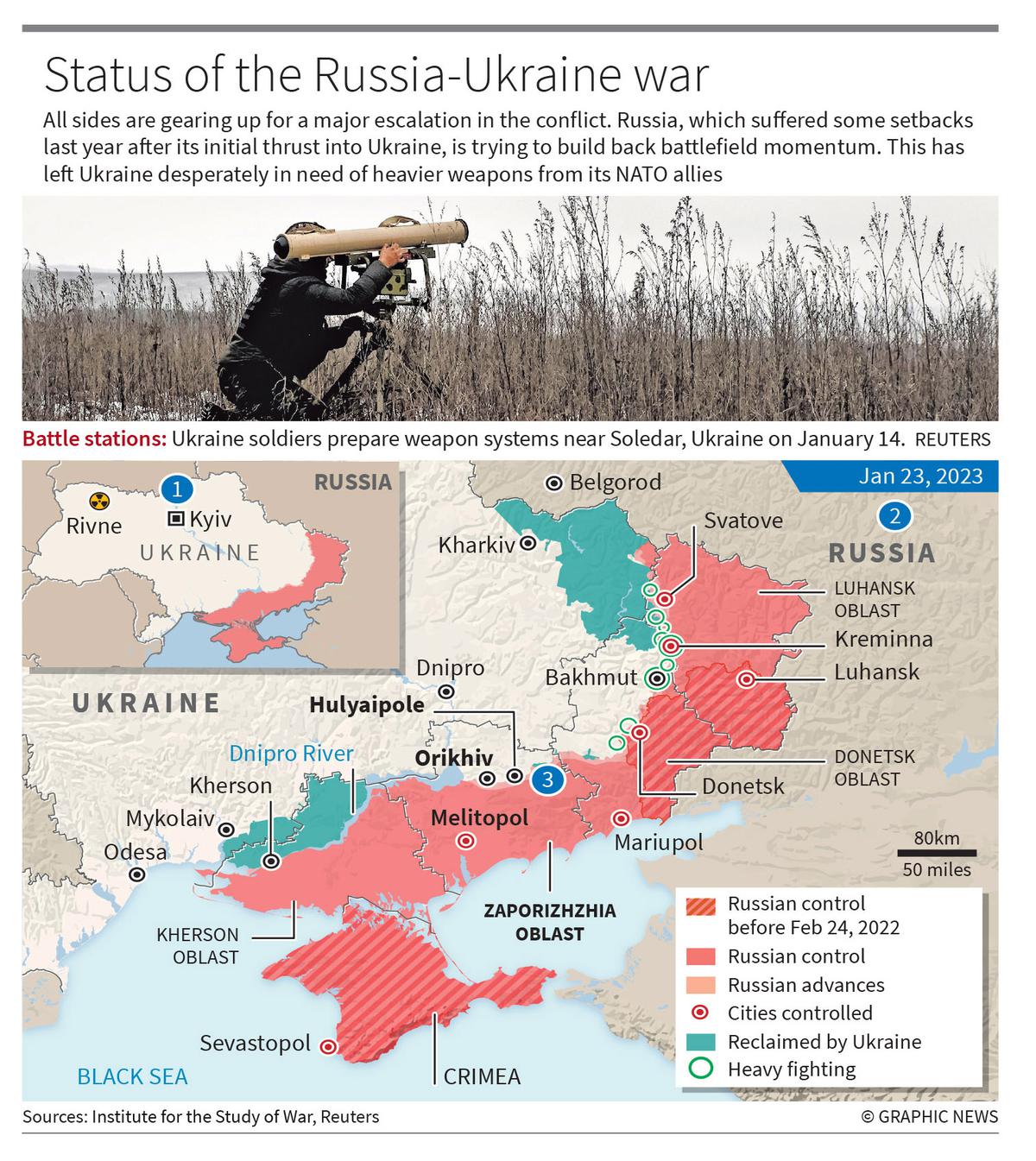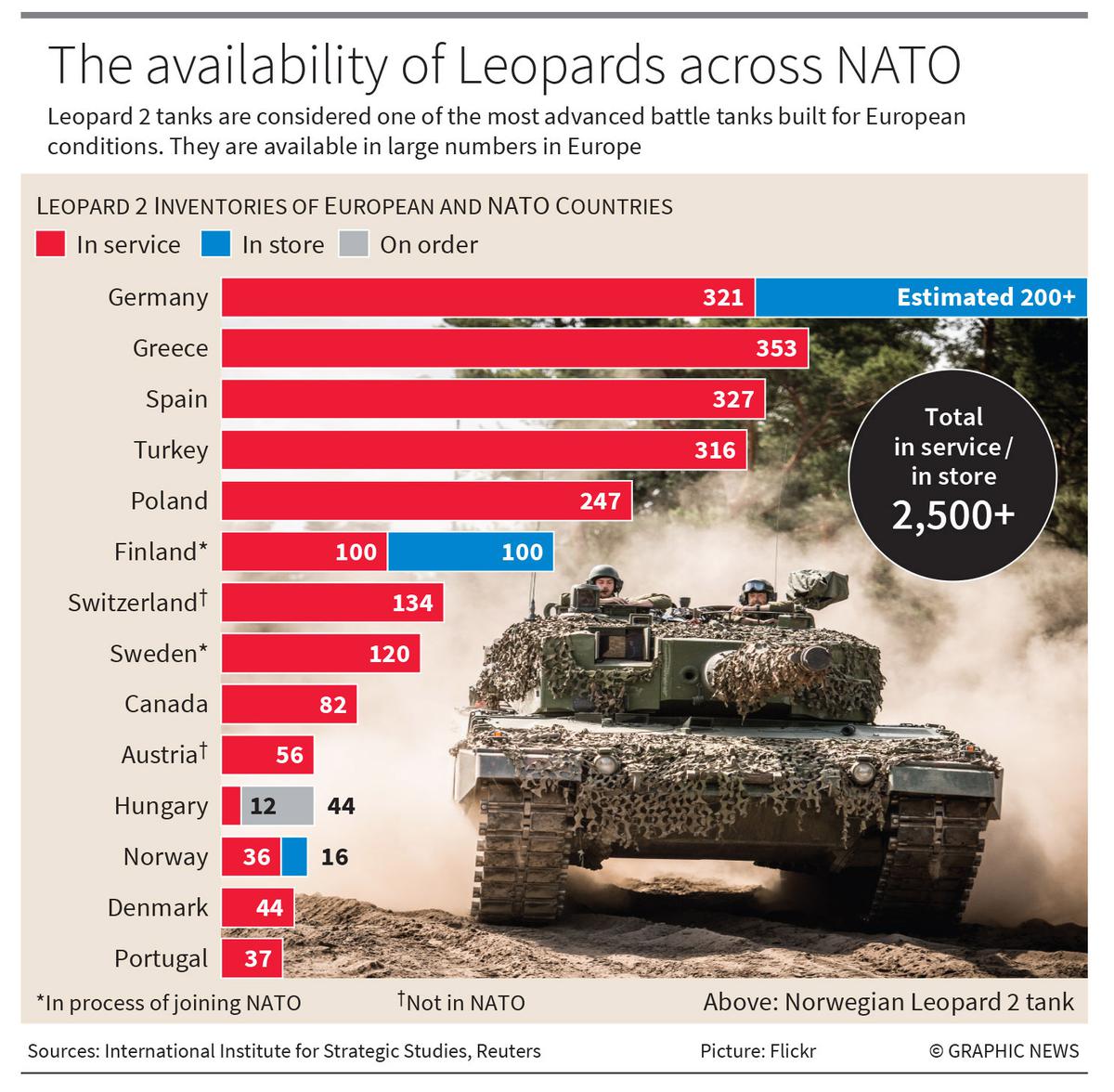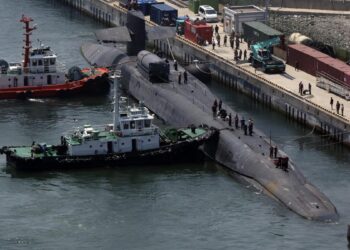The story so far: As Russia’s Ukraine invasion enters its 12th month, all sides are gearing up for a major escalation in the conflict. Russia, which suffered some setbacks last year after its initial thrust into Ukraine, is trying to build battlefield momentum with minor advances. Ukraine, whose troops are struggling to defend the frontlines in the east and south, is asking for heavier weapons from its NATO allies. While Germany’s early resistance to sending its Leopard 2 battle tanks to Ukraine created a rift within NATO, it has now finally agreed to send the tanks and allow other countries to re-export German-built tanks to Ukraine. The U.S., after initial reluctance, is also sending its M1 Abrams tanks to Kyiv.
What is the current state of the war?
After Ukraine, which launched a counteroffensive in September, recaptured swathes of the Kharkiv Oblast in the northeast and Kherson city in the south, (the only provincial capital the Russians had taken since the war began) the conflict had turned into a war of attrition — until recently.
Russian troops, predominantly the private military Wagner Group, have been trying to seize Bakhmut, a city in Donetsk in the Donbas region which Moscow now claims as its own, for the past six months. As those efforts did not bear fruit, in recent weeks, Russia’s focus shifted to Soledar, a town that lies just 18 km from the city of Bakhmut. Russian troops tore through the Ukrainian defences in Soledar rather quickly, taking the town, and making further advances towards Bakhmut.

In the south, Moscow claimed that its troops have pushed through the frontlines in Zaporizhzhia, one of the four Ukrainian provinces Russian President Vladimir Putin unilaterally annexed in September. As of now, Russia controls only parts of the Zaporizhzhia province, including its eponymous nuclear plant, Europe’s largest. But by pushing through the frontlines in the east and the south, Russia is mounting enormous pressure on Ukraine’s army, which set alarm bells ringing in Kyiv and western capitals.
Ukraine now demands urgent supplies and the West is scrambling for weapons.
Who is supplying Ukraine?
Supplies from the West are vital for Ukraine in the conflict. The U.S., Ukraine’s largest defence supplier, has committed to sending Kyiv more than $27 billion in military aid since the war began. It is sending ammunition, howitzers, helmets, Humvees and HIMARS rocket systems. The U.S. has also promised to send Stryker combat vehicles and deploy a Patriot missile defence battery.
The U.K. and Germany are the next two big suppliers of military equipment and arms for Ukraine. Earlier this month, London announced that it would provide 14 Challenger 2 battle tanks to Kyiv, while France said it would ship AMX-10RC armoured vehicles, known as the tank killer, to Ukraine. While Ukraine thanked its allies for these commitments, they also said these were not enough to beat the Russians.
They wanted more tanks for the coming land war. NATO allies wanted Germany to send its Leopard 2 tanks, considered one of the most advanced battle tanks built for European conditions. But Germany was initially reluctant to provide Leopard to Ukraine despite frantic calls from Kyiv and other allies.
Why was Germany reluctant to send its tanks?
Ever since the war began Germany has sent multiple offensive weapons to Ukraine, from self-propelled howitzers to rocket launchers. But Chancellor Olaf Scholz initially refused to send tanks to Ukraine, saying such a move would escalate the conflict further, which was not in Berlin’s interest. Germany, being geographically closer to Russia and lacking its own nuclear deterrent (say, unlike France and the U.K), sees itself in a disadvantageous position in the event of a direct confrontation between NATO and Russia. Both Mr. Scholz’s party and the public are divided on the tank question.
According to a December poll, some 50% of Germans opposed sending tanks to Kyiv against 38% who favoured it. Berlin was also worried that Russians could capture the tanks and gain insights into its technology. Moreover, German officials told the media, that Mr. Scholz was sensitive to the historical context — during the Second World War, German tanks rolled over into today’s Ukraine, which was part of the Soviet Union, as Hitler ordered his disastrous Russian invasion. But Germany also came under heavy pressure from its allies, especially the U.S. and Poland, to take a quick decision.
After the initial caution, the U.S.’s risk appetite in the conflict has steadily increased with the Biden administration beefing up Kyiv’s military capabilities. Berlin said it would consider sending Leopard if the U.S. agreed to send its Abrams tanks. The U.S. had initially ruled it out, saying Abrams, run of jet fuel, were complex systems which would require months to train Ukrainian troops. A meeting last week at the Ramstein Air Base in Germany of the Ukraine support group ended without a decision on tanks, showing signs of rifts in the NATO alliance. But back channel diplomacy continued.
On Wednesday, Germany announced that it would send 14 Leopard 2 tanks to Kyiv and allow other NATO members to re-export German-made tanks to Ukraine. Biden administration officials said in Washington that the U.S. would also send Abrams tanks to Kyiv.
Why does Ukraine want Leopards?
Ukraine has a limited number of tanks, most of which are from the Soviet era. Ukrainian leaders have said that they believe Moscow is planning a major offensive in the coming months.
The lack of advanced tanks could put Kyiv in a disadvantageous position in Ukraine’s open terrain, especially when Russia has deployed its modern T-90s. Ukraine has asked for 300 tanks. Leopards, with a range of 500 km and a top speed of 68 km an hour and armed with a 120mm smooth bore gun and two coaxial light machine guns, could bolster offensive capabilities. Leopards are also available in large numbers in Europe.

More than 2,000 Leopard 2s have been deployed across Europe and if Germany allows their re-export, NATO members can ensure smooth supply to Ukraine.
What next?
It was after Russia’s back-to-back battlefield victories in Donbas (Mariupol, Severodonetsk and Lysychansk) that the U.S. agreed to send its advanced rocket systems (High Mobility Artillery Rocket Systems or HIMARS and Multiple Launch Rocket Systems or MLRS) to Ukraine. These weapons played a critical role in Ukraine’s counteroffensive that saw Russian troops retreat from Kharkiv and Kherson.
Now, Russian troops seem to have regrouped and built stronger defensive positions across the frontline, stretching from the borders of Kharkiv to Kherson. With some 3,00,000 new conscripts joining its forces, Russia is likely to make another push. The recent advances it made in Soledar and Zaporizhzhia could be signs of what is coming.
If Russia takes Bakhmut in the east and Zaporizhzhia in the south, it could boost its logistical capabilities to make deeper inroads into Ukraine. Kyiv wants to stop this by launching its own offensive.
If Ukraine reverses Russia’s gains in Zaporizhzhia and cuts deeper into the south, it could sever the Russian-controlled south and east, sabotaging Moscow’s land bridge to Crimea, the Black Sea peninsula that Mr. Putin annexed in 2014.
With more heavy weapons coming from the West, Ukraine wants to be better prepared for the Russians.
















